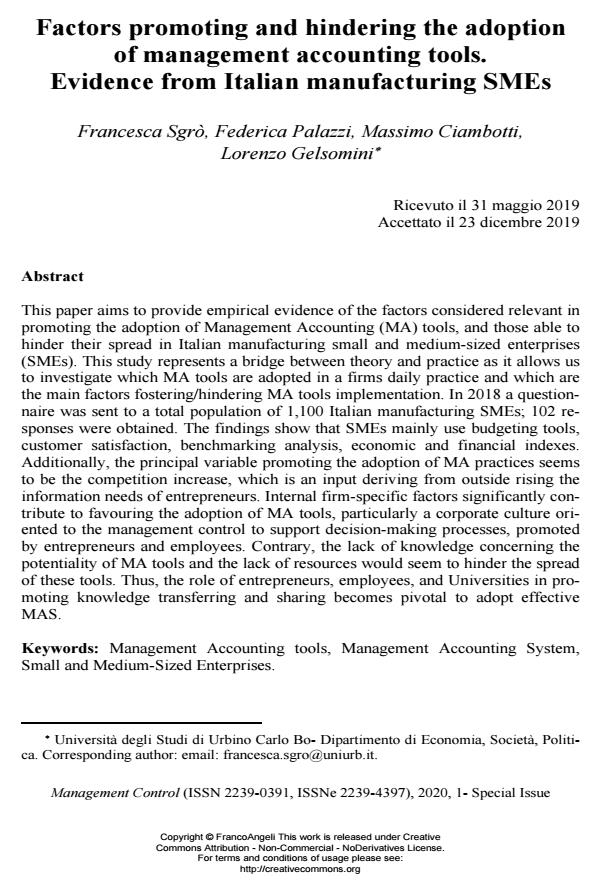Factors promoting and hindering the adoption of management accounting tools. Evidence from Italian manufacturing SMEs
Titolo Rivista MANAGEMENT CONTROL
Autori/Curatori Francesca Sgrò, Federica Palazzi, Massimo Ciambotti, Lorenzo Gelsomini
Anno di pubblicazione 2020 Fascicolo 2020/Suppl. 1
Lingua Inglese Numero pagine 20 P. 19-38 Dimensione file 249 KB
DOI 10.3280/MACO2020-001-S1003
Il DOI è il codice a barre della proprietà intellettuale: per saperne di più
clicca qui

FrancoAngeli è membro della Publishers International Linking Association, Inc (PILA)associazione indipendente e non profit per facilitare (attraverso i servizi tecnologici implementati da CrossRef.org) l’accesso degli studiosi ai contenuti digitali nelle pubblicazioni professionali e scientifiche
This paper aims to provide empirical evidence of the factors considered relevant in promoting the adoption of Management Accounting (MA) tools, and those able to hinder their spread in Italian manufacturing small and medium-sized enterprises (SMEs). This study represents a bridge between theory and practice as it allows us to investigate which MA tools are adopted in a firms daily practice and which are the main factors fostering/hindering MA tools implementation. In 2018 a ques-tionnaire was sent to a total population of 1,100 Italian manufacturing SMEs; 102 responses were obtained. The findings show that SMEs mainly use budgeting tools, customer satisfaction, benchmarking analysis, economic and financial indexes. Additionally, the principal variable promoting the adoption of MA practices seems to be the competition increase, which is an input deriving from outside rising the information needs of entrepreneurs. Internal firm-specific factors significantly contribute to favouring the adoption of MA tools, particularly a corporate culture oriented to the management control to support decision-making processes, pro-moted by entrepreneurs and employees. Contrary, the lack of knowledge concern-ing the potentiality of MA tools and the lack of resources would seem to hinder the spread of these tools. Thus, the role of entrepreneurs, employees, and Universities in promoting knowledge transferring and sharing becomes pivotal to adopt effec-tive MAS.
Parole chiave:Management Accounting tools, Management Accounting System, Small and Me-dium-Sized Enterprises
- Business continuity and planning effectiveness: An empirical analysis of Italian manufacturing SMEs Francesca Sgrò, Federica Palazzi, Massimo Ciambotti, in MANAGEMENT CONTROL 3/2022 pp.89
DOI: 10.3280/MACO2022-003005 - The moderating effect of corporate size on the relationship between prospector strategy and management accounting practices Federica Palazzi, Francesca Sgrò, Massimo Ciambotti, Nick Bontis, Lorenzo Gelsomini, in Journal of Management Control /2023 pp.135
DOI: 10.1007/s00187-023-00353-2 - Integrating Change Management and Management Accounting Change Lorenzo Leto, pp.1 (ISBN:978-3-031-84386-0)
- Creating Value Through Sustainability Lorenzo Leto, Diletta Vito, Francesca Bernini, pp.65 (ISBN:978-3-031-74291-0)
- Integrating Change Management and Management Accounting Change Lorenzo Leto, pp.57 (ISBN:978-3-031-84386-0)
- Implementazione di Sistemi di Misurazione delle Performance nelle PMI: elementi di analisi nella prospettiva del cambiamento organizzativo Nicola Castellano, Lorenzo Leto, in MANAGEMENT CONTROL 1/2021 pp.129
DOI: 10.3280/MACO2021-001007 - [Retracted] Construction of Accounting Internal Control Management Platform Based on IoT Cloud Computing Li Song, Jun Ye, in Wireless Communications and Mobile Computing 9552118/2022
DOI: 10.1155/2022/9552118 - Performance Management Systems in Micro, Small, and Medium Enterprises: Lessons learned from Times of Uncer Laura Broccardo, Elisa Ballesio, Edoardo Crocco, Daniele Giordino, in MANAGEMENT CONTROL 3/2024 pp.15
DOI: 10.3280/MACO2024-003002 - Integrating Change Management and Management Accounting Change Lorenzo Leto, pp.21 (ISBN:978-3-031-84386-0)
- Il contributo dei sistemi di RM e PM alla sostenibilità integrata: il caso B&C Speakers Lorenzo Leto, Diletta Vito, in MANAGEMENT CONTROL 3/2024 pp.113
DOI: 10.3280/MACO2023-003006
Francesca Sgrò, Federica Palazzi, Massimo Ciambotti, Lorenzo Gelsomini, Factors promoting and hindering the adoption of management accounting tools. Evidence from Italian manufacturing SMEs in "MANAGEMENT CONTROL" Suppl. 1/2020, pp 19-38, DOI: 10.3280/MACO2020-001-S1003